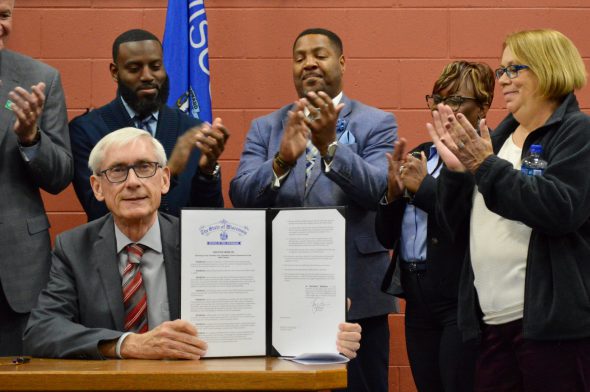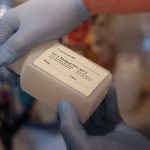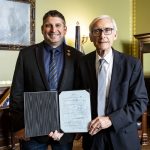Why The Census Matters to Milwaukee
What you need to know about the Census and why it matters to state, nation.

The Census Bureau is looking for people to be a census taker for the 2020 census. Photo by Sue Vliet/NNS.
Shortly after returning home from school one day in spring 2010, Iuscely Flores, who was 13 at the time, and her mother heard a knock on the door. Peering through the window, Flores’ mother saw a man dressed in business casual holding a laptop with a lanyard around his neck.
Her mother was hesitant to open the door. At the time, ICE raids were becoming more frequent and the Flores family, as undocumented residents, didn’t want to risk deportation. When Flores realized the man was a census taker, she encouraged her mother to open the door.
“I remember telling my mom, it’s going to be OK. I learned about this in school,” she said.
Eventually, the man came inside and for nearly an hour, Flores translated for her mother, as the census taker noted everyone who was living in the house.
Currently, Flores works for Wisconsin Voices, an organization that aims to increase civic engagement. In her role as canvass training manager for the census, Flores shares her story and works on encouraging more people to participate in the census.
While the census is still a couple of months away, here’s what you need to know about what it means for Wisconsin and the nation as a whole.

Gov. Tony Evers signs an executive order for a Complete Count Committee for the 2020 census. Photo by Ana Martinez-Ortiz/NNS.
What is the census and its purpose?
The census, in basic terms, is a way for the government to count every living person in the country.
The census serves many purposes. During a news conference, Rep. David Crowley (D-Milwaukee) explained the importance of the census. The population of a state determines how many seats it receives in the House of Representatives through reapportionment. It contributes to a state’s redistricting plan. And it determines how much each state receives in terms of federal funding.
There’s $675 billion of federal funding that is split among the states each year, he said. This funding contributes to education, Medicare, transportation and more.
What is the history of the census?
The first census was collected in 1790 when there were 13 states, Thomas Jefferson was the bureau’s director and the U.S. resident population totaled nearly 4 million people.
Jefferson, who was secretary of state, spearheaded the census. Under his leadership, U.S. marshals conducted a six-question survey, which was to be done every 10 years. The questions included name, age, sex and race.
In 1830, Congress approved the printing of a more uniform questionnaire. In 1940, the census had two surveys, one to count the population and the other to collect housing information. This later changed in 1960, when the two surveys were combined. In 1970 through 2000, a short-term survey was sent to all households, with a long-term survey about the household sent to some homes. In 2010, the census consisted of 10 questions.
What are hard-to-count communities?
Marilyn Sanders, a regional director for the U.S. Census Bureau, said the data have shown that hard-to-count communities include single parent households, children under the age of 5 and seniors.
Sharon Robinson, the co-chairwoman of the Greater Milwaukee Complete Count Committee and director of the department of administration for the City of Milwaukee, said the hard-to-count communities also include the homeless, Latinx, African Americans and LGBTQ+ populations.
“Our census affects the monetary resources that our state can get,” Lt. Gov. Mandela Barnes said. “Meaning for every person not counted our state loses out on nearly $1,400 per person per year.”
During a news conference, Gov. Tony Evers said the hard-to-count population in Wisconsin is more than 600,000.
What is being done to count HTC?
Sanders noted that the hard-to-count populations are typically uneducated when it comes to the census and its importance. The future starts with the count for 2020, she said.
Groups such as the Complete Count Committee and Wisconsin Voices are working hard to educate people from those backgrounds on the importance of the census. To do this, the groups are relying on trusted voices in those communities to educate people on the census and that it’s quick, safe and private.
Robinson said that the Greater Milwaukee Complete Count Committee is working to break down barriers that may prohibit people from participating in the census. Part of the plan includes setting up kiosks or stations where people can take the census online. For example, the Milwaukee Public Library will have computer spaces available as well as places such as Employ Milwaukee.
What are some misconceptions surrounding the census?
There are many misconceptions when it comes to the census. Robinson said one of the most common is that it will take a long time or is inconvenient. Doing it online or by phone is quick and easy, she said, and can take about 10 minutes.
Sanders said the information collected by the census is completely private and cannot be shared with anyone.
Title 13 protects an individual’s information and prohibits it from being shared with any organization including law enforcement. Census Bureau employees are sworn to confidentiality and can face five years in a federal prison, a fine up to $250,000, or both, for violations.
A census taker will also have a census badge with an identification number, which can be verified by the Census Bureau, Sanders said.
How is data being collected for the 2020 census?
The official census date is April 1, 2020. For the 2020 census, the data will initially be gathered in one of three ways: online, by mail or by phone.
Census takers will go door to door starting in June 2020 until the end of July 2020.
The online form and telephone line will be available in 13 languages including English, according to the U.S. Census Bureau. Additionally, there will be language guides available in 59 languages other than English.
What happens after the data is collected?
On Dec. 31, 2020, the Census Bureau will report the population count to the president and the reapportionment of house seats. The following year in 2021, some census findings will be available to the public.
What can people do to help?
People can help by being a census taker or simply by spreading the word at work, parties, places of worship and elsewhere. To become a census taker, click here or call 1-855-JOB-2020.
This story was originally published by Milwaukee Neighborhood News Service, where you can find other stories reporting on fifteen city neighborhoods in Milwaukee.
Political Contributions Tracker
Displaying political contributions between people mentioned in this story. Learn more.




















